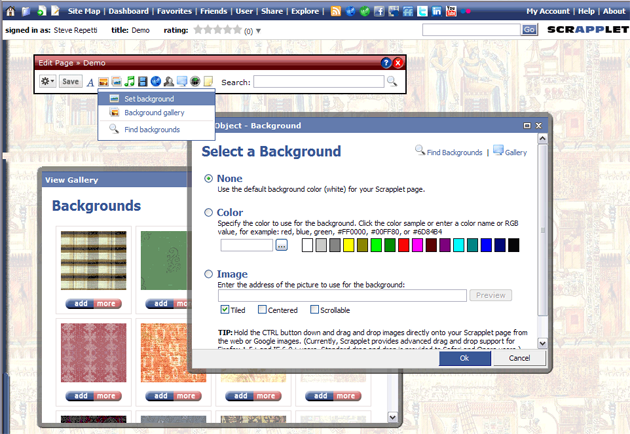There are a few sites out there that let you aggregate your entire online presence into a single place, but for the most part they offer little control over the way your information is actually presented. Today sees the launch of Scrapplet, a powerful new website/platform based entirely on JavaScript that allows users to design pages combining all of this information to their liking using a WYSIWYG interface. The site also offers a dizzying array of options – so many, in fact, that the site could be used by experienced developers to create pages that go far beyond showing off your interests and favorite photos.
CEO Steve Repetti stresses that Scrapplet isn’t another social network – rather, it’s a place for you to compile all of your information from sites across the web and present it however you’d like. The site gives users a blank canvas, allowing them to import information from sites including Facebook, Twitter, MySpace, RSS feeds, and a number of other sources. You can also embellish your profile with music, embedded videos, and images.
Once you’ve imported all of your content, you can drag and drop each item wherever you’d like in your canvas. Each item also has a properties menu that allows you to customize how it should behave (for example, you can determine if it should have a border or if it should “stick” to another item on your canvas, or if should move independently when it’s dragged). More advanced options include a Timer, Rollover, and OnClick actions that allow you to execute commands accordingly.

To novice computer users, Scrapplet’s wide array of available options can be daunting at first. Immediately after registering, I was presented with a page full of default widgets, asking me to add a profile picture, configure my guestbook, list a few of my favorite things, and so on – there was so much there that I simply didn’t know where to start. Fortunately the site offers a listing of Scrapplets created by other users, which gives an idea of what’s available. Repetti says that while there is a learning curve, once you’ve got the basics down it becomes much more intuitive (as proof as its wide accessibility, he directed me to this canvas, which was created by a user named Rockin’ Grandma). Still, it would be nice if the site offered a better tutorial, or allowed users to go into ‘Easy’ mode by eliminating advanced options entirely.
Besides appealing to more casual users, Scrapplet also has the potential to become very popular for businesses and experienced developers. Because users are free to append their canvases with extra code, developers can enhance their Scrapplet pages, leveraging the platform to quickly build powerful web apps. For an example, check out this sample Gallery Scrapplet, which showcases some of the site’s layering and lighting effects in a virtual art gallery.
Repetti is a member of the board of the DataPortability project, so it comes as little surprise that Scrapplet canvases can be exported to a number of widespread formats, and it’s also easy to share to other social online services. The site also readily supports logins through OpenID, as well as other sites like Facebook. Scrapplet is going to be free for most users, who will probably be fine with only a few canvas pages. Users with more than 7 canvas pages or who want to present their canvases on a custom domain will need to become paid members, with memberships beginning at around $2.95 per month.
